On this page
Ornithological Monographs 50 to 80This page lists the Ornithological Monographs, numbers 50 to 80, produced by the American Ornithologists' Union. The monographs comprise major papers and presentations that are too long for inclusion in the Union's journal, The Auk. The first monograph in the series was published in 1964.
The list is split over two pages:
- Monographs 50 to 80
- Monographs 1 to 49
American Ornithologists' Union
There are two other American Ornithologists' Union pages on the site:
Series In ornithology
Anatomical Inventory Series
For more information see the AOU website
|
|
|
|
Sex and Age Differences in Site Fidelity, Food Resource Tracking, and Body Condition of Wintering Kirtland's Warblers (Setophaga kirtlandii) in the BahamasJoseph M. Wunderle Jr., Patricia K. Lebow, Jennifer D. White, Dave Currie and David N. Ewert
Ornithological Monographs 80
American Ornithologists' Union
2014
From the abstract: "Distribution of nonbreeding migrant birds in relation to variation in food availability has been hypothesized to result from the interaction of dominance hierarchies and variable movement responses, which together may have sex- and age-specific consequences. We predicted that site fidelity, movements, and abundance of Kirtland's Warblers (Setophaga kirtlandii) wintering on the island of Eleuthera in the Commonwealth of the Bahamas (hereafter "The Bahamas") would be correlated with food abundance but vary by sex and age. We found that the species' food resources (fruits and arthropods) typically declined during a winter but varied between winters (years) and study sites. Rainfall is a driver of variation in fruit abundance, as indicated by an information-theoretic evaluation of abiotic factors that influence fruit abundance. Despite variation in food availability, the proportions of fruits and arthropods in the diet of Kirtland's Warblers (88% of 90 fecal samples with both) varied little within or between winters or with sex or age class. Overwinter site persistence was low and variable among study sites (average = 43%, range: 11–67%); as predicted, site fidelity within and between winters differed by sex (males > females) and age class (adults > juveniles). However, knowledge of only sex and age was insufficient to predict site persistence in a model-selection framework in the absence of other contributing variables from the confidence set of models (i.e., food resources and/or habitat structure) for two model sets. These analyses further indicated that measures of food resources, either foliage arthropods or fruits, were reliable positive predictors of site fidelity, given the respective confidence set of models."
|
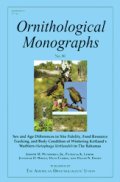 |
|
Migratory Tactics and Wintering Areas of Northern Gannets Breeding in North AmericaDavid A. Fifield, William A. Montevecchi, Stefan Garthe, Gregory J. Robertson, Ulrike Kubetzki, and Jean-Francois Rail
Ornithological Monographs 79
American Ornithologists' Union
2014
From the abstract: " Migration has evolved to allow organisms to undertake life-history functions in the most appropriate place at the most appropriate time. Migration creates seasonal ecological linkages that have important implications for survival, population dynamics, response to climate change, and conservation. Although advances in bird-borne tracking technology have promoted knowledge of avian migratory ecology, major information gaps remain for most avian species, including seabirds. Ours is the first study to electronically track the migration and wintering of Northern Gannets (Morus bassanus; hereafter "gannets") from almost all of their North American breeding range, in multiple years and with multiple tracks from individual birds."
|
 |
|
Predictors of Juvenile Survival in BirdsTerri J. Maness and David J. Anderson
Ornithological Monographs 78
American Ornithologists' Union
2013
Abstract: "The survival probability of birds during the juvenile period, between the end of parental care and adulthood, is highly variable and has a major effect on population dynamics and parental fitness. As such, a large number of studies have attempted to evaluate potential predictors of juvenile survival in birds, especially predictors related to parental care. Lack's hypothesis linking body reserves accumulated from parental care to the survival of naive juveniles has organized much of this research, but various other predictors have also been investigated and received some support. We reviewed the literature in this area and identified a variety of methodological problems that obscure interpretation of the body of results. Most studies adopted statistical techniques that missed the opportunities to (1) evaluate the relative importance of several predictors, (2) control the confounding effect of correlation among predictor variables, and (3) exploit the information content of collinearity by evaluating indirect (via correlation) as well as direct effects of potential predictors on juvenile survival. Ultimately, we concluded that too few reliable studies exist to allow robust evaluations of any hypothesis regarding juvenile survival in birds. We used path analysis to test potential predictors of juvenile survival of 2,631 offspring from seven annual cohorts of a seabird, the Nazca Booby (Sula granti). Fledging age was the most important predictor of juvenile survival: fast-growing offspring survived best, when all other variables were held constant. Offspring sex was the next most important predictor, with juvenile males (the smaller sex) surviving better than females. Hatching day, an index of body weight, and wing length also showed important predictive ability, but cohort size, culmen length, and an index of clutch size and hatching success did not. Nestling growth was compromised under poor rearing conditions: overall weight fell, the number of days needed to reach fledging status increased, and the growth of some structures, but not others, was reduced. These effects were more pronounced in females, and the higher juvenile mortality of females accounts for most of the male bias in the adult sex ratio and its attendant "mate rotation" mating system in this population. Most previous studies did not evaluate sex as a potential predictor of juvenile survival. Had we omitted sex from our models, we would have made two erroneous conclusions: that weight did not influence juvenile survival, and that small structural size enhanced it."
|
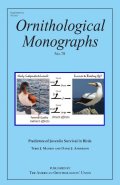 |
|
Introduction to the Skeleton of Hummingbirds (Aves: Apodiformes, Trochilidae) in Functional and Phylogenetic ContextsRichard L. Zusi
Ornithological Monographs 77
American Ornithologists' Union
2013
From the abstract: "Historically, comparative study of the skeleton of hummingbirds has focused on systematics, emphasizing differences between hummingbirds and other birds and only rarely addressing differences within Trochilidae. This monograph covers both approaches, and comparisons within Trochilidae are framed within recently published, plausible phylogenetic hypotheses. The data are derived mainly from museum collections of anatomical specimens, covering 256 species of 102 genera of hummingbirds, and 11 genera of other Apodiformes. Although the syringeal skeleton is included, emphasis is on the axial and appendicular skeletons."
|
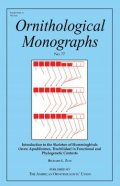 |
|
Diversity, Prevalence, and Host specificity of Avian Plasmodium and Haemoproteus in a Western Amazon AssemblageMaria Svensson-Coelho, John G. Blake, Bette A. Loiselle, Amanda S. Penrose, Patricia G. Parker and Robert E. Ricklefs
Ornithological Monographs 76
American Ornithologists' Union
2013
Abstract:"We used PCR and DNA sequencing to screen for haemosporidian parasites (Haemoproteus and Plasmodium) in 2,488 individual birds from 104 species and 22 families, primarily understory suboscine passerines, captured in a lowland Amazonian forest in Ecuador as a first major step to understanding the transmission dynamics of this cosmopolitan group of parasites in this region. To assess diversity of avian haemosporidia in our study site, we identified putative evolutionary lineages of haemosporidia using the mtDNA gene cytochrome b (cyt b). We sampled birds over 9 years, which allowed us to assess annual variation in haemosporidian prevalence. Additionally, we investigated among-species variation in prevalence and tested relationships between traits of hosts and prevalence of haemosporidia in a comparative analysis. Finally, we estimated host specificity of each recovered parasite lineage and compared several indices with different details of host information. Prevalence of haemosporidia was 21.7% when we combined years and ranged from 5.6% to 91.2% among well-sampled host species. Prevalence varied significantly among years, ranging from 14.5% in 2006 to 33.2% in 2009. The hypothesis that haemosporidian prevalence increases with level of sexual dimorphism and decreases with foraging height of a host species received some support. We identified 65 unique cyt b haplotypes, some of which we considered variation within the same evolutionary lineage. In total, we defined 45 putative evolutionary lineages based on 363 identified parasites. Fourteen haplotypes were identical to haplotypes found elsewhere, sometimes on different continents. Host specificity varied greatly among parasite lineages. Collectively, our findings indicate that within a local Neotropical assemblage of avian haemosporidia, community organization is highly complex and part of this complexity can be attributed to differences in host life history; diversity, particularly of Plasmodium spp., is high; and individual parasite lineages can differ greatly in both abundance and number of host species."
|
 |
|
Ecology of Willow Flycatchers (Empidonax traillii) in the Sierra Nevada, California: Effects of Meadow Characteristics and Weather on DemographicsHeather A. Mathewson, Michael L. Morrison, Helen L. Loffland and Peter F. Brussard
Ornithological Monographs 75
American Ornithologists' Union
2013
"Population declines in songbirds are often attributed to regional habitat loss and fragmentation caused by land-use practices, which might be further aggravated by climate change. These concerns are particularly evident in the Intermountain West, where riparian areas are considered a priority for conservation because of predicted reductions in winter precipitation and increases in spring temperatures. These climatic changes might increase the susceptibility of species reliant on riparian areas to regional extirpation from loss of habitat. The willow flycatcher (Empidonax traillii) is a California species of concern because of precipitous population declines in the past three decades. In 1997, we established a long-term research program to determine population demographics and the effects of weather events and regional-scale meadow distribution and vegetative structure on nesting success of willow flycatchers. We monitored territory establishment and reproductive success of 786 territories and 850 nests in meadows distributed south and north of Lake Tahoe, California, from 1997 to 2008. We documented near extirpation of willow flycatchers south of the lake and a declining trend in the number of territories north of the lake. Late-spring storms and low temperatures at the start of the breeding season reduced the length of the breeding season, affecting the ability of willow flycatchers to renest. Nest age better predicted nest survival than meadow-scale landscape and weather variables. Although weather parameters were not significant as a direct influence on nest survival analyses, our results suggested a weak negative relationship with increased snowfall. For our nest-scale model evaluation, over-nest vegetation concealment increased nest survival in large meadows but had little effect on nest survival in smaller meadows."
|
Buy from amazon.co.uk 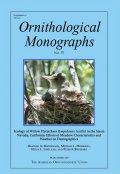
|
|
The Influence of Anthropogenic Noise on Birds and Bird StudiesEditor: Clinton D Francis and Jessica L Blickley
Ornithological Monographs 74
American Ornithologists' Union
2012
Chapters:
- Introduction: Research and perspectives on the study of anthropogenic noise and birds
- Effects of noise pollution on birds: A brief review of our knowledge
- Potential acoustic masking of Greater Sage-Grouse (Centrocercus urophasianus) display components by chronic industrial noise
- Behavioral responses by two songbirds to natural-gas-well compressor noise
- Acoustic space is affected by anthropogenic habitat features: Implications for avian vocal communication
- Constraints on acoustic signaling among birds breeding in secondary cavities: The effects of weather, cavity material, and noise on sound propagation
- Effects of gas-well-compressor noise on the ability to detect birds during surveys in northwest New Mexico
- Experimental determination of the response of Golden-cheeked Warblers (Setophaga chrysoparia) to road construction noise
- Are nest predators absent from noisy areas or unable to locate nests?
|
 |
|
Ecogeographic Patterns of Morphological Variation in Elepaios (Chasiempis spp.): Bergmann's, Allen's, and Gloger's Rules in a MicrocosmEric A. VanderWerf
Ornithological Monographs 73
American Ornithologists' Union
2012
"Animals often exhibit predictable geographic variation in morphology, and such ecogeographic patterns reflect local adaptation to varying environmental conditions. The most common of these patterns are termed Bergmann's, Allen's, and Gloger's rules. I studied morphological variation in the Hawaii elepaio (Chasiempis sandwichensis) and the Oahu elepaio (C. ibidis), forest birds endemic to the Hawaiian Islands. I measured body size and plumage color of 223 live elepaios captured at 36 sites on Hawaii and 132 live elepaios captured at 23 sites on Oahu, and I examined 132 museum specimens from an additional 22 locations on Hawaii. I used multiple regressions to examine relationships of elepaio body size and plumage color to elevation and annual rainfall on each island. Size of Hawaii elepaios varied among sites and was related to elevation and rainfall. Wing chord, tail length, and body mass had positive relationships with elevation, as predicted by Bergmann's rule. Proportional bill length and proportional tarsus length were inversely related to elevation, as predicted by Allen's rule."
|
Buy from amazon.co.uk 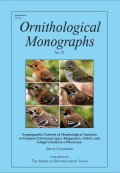
|
|
An Alphataxonomic Revision of Extinct and Extant Razorbills (Aves, Alcidae): A Combined Morphometric and Phylogenetic ApproachEditors: N. Adam Smith and Julia A. Clarke
Ornithological Monographs 72
American Ornithologists' Union
2011
"Alca (Aves, Alcidae) has a comparatively rich fossil record with respect to other Charadriiformes, consisting of thousands of specimens. Despite the abundance of fossil material, species richness in this clade has remained poorly understood, primarily because of the paucity of associated specimens. To address this issue, a combined morphometric and apomorphy-based method was developed that would allow referral of fragmentary and isolated specimens, which constitute ~97% of the Alca fossil record. Measurements of multiple variables from >2000 Alca fossils were categorized by hierarchical cluster analysis and resulted in the recognition of species clusters. Discriminant function analysis was used to assess statistical support for these clusters and to identify the most informative measurements with respect to discriminating between species on the basis of size. The reliability of this method was tested using the same measurements taken from 13 extant alcid species and was found to be robust with respect to the accurate recovery of species-correlated groups of measurement data. With the exception of the similarly proportioned Alca carolinensis sp. nov. and A. olsoni sp. nov., the holotype specimens of all Alca species were recovered in separate, statistically supported clusters. These clusters of fossils were then evaluated for the presence of diagnostic morphological features, resulting in the recognition of three new Alca species. In contrast to previously described Alca species, two new species are described from holotype specimens that are associated partial skeletons. These associated specimens facilitated referral of isolated fossil material and phylogenetic estimation of alca relationships. Amended diagnoses for Alca species are proposed, and 203 humeri are referred to species on the basis of unique suites of characters and size ranges identified through these analyses. This method has potential for assessing species diversity in other taxa known from abundant fragmentary and/or isolated remains. The combined phylogenetic analysis includes the three new species described herein, nine extinct species in Alcini that have not been phylogenetically analyzed before, and six other extant or recently extinct (i.e., great auk [Pinguinus impennis]) Alcini species. The character matrix includes osteological characters and previously published molecular sequence data (ND2, ND5, ND6, CO1, CYTB, 12S, 16S, RAG1). The results support the monophyly of an Alca + Pinguinus clade recovered as the sister taxon to a clade composed of Uria, Miocepphus, and Alle. The description of three new species of auk from the Early Pliocene Yorktown Formation of North Carolina nearly doubles the number of known species in Alca, makes Alca the most speciose clade of Atlantic alcids, and supports previous hypotheses of high species richness in this clade. The sole extant species, the razorbill auk (Alca torda), may accordingly be viewed as the only survivor of a diverse Atlantic Ocean clade that was species-rich a mere 4 million years ago. These new fossils refine our knowledge of alcid paleodiversity, provide information regarding ancestral osteological states within Alca, and allow for increased understanding of radiation, extinction, and biogeography within this clade."
|
Buy from amazon.co.uk 
|
|
Are Wild Birds Important in the Transport of Arthropod-Borne Viruses?Charles R. Brown and Valerie A. O'Brien
Ornithological Monographs 71
American Ornithologists' Union
2011
"The encephalitic arthropod-borne viruses (arboviruses) can cause a variety of serious human and wildlife diseases, including eastern equine encephalomyelitis, western equine encephalomyelitis, St. Louis encephalitis, Japanese encephalitis, and West Nile neuroinvasive disease. Understanding how these pathogens are dispersed through the environment is important both in managing their health-related impact and in interpreting patterns of their genetic variability over wide areas. Because many arboviruses infect wild birds and can be amplified to a level that makes birds infectious to insect vectors, numerous workers have suggested that the movements of migratory birds represent a major way that these viruses can be transported on a local, continental, and intercontinental scale. Virus transport by birds can, in theory, explain the colonization of new geographic regions by arboviruses, why some arboviruses in widely separated areas are genetically similar, and how arboviruses annually recur in temperate latitudes following interrupted transmission during the winter months."
|
Buy from amazon.co.uk 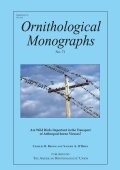
|
|
Avifauna of the Eastern Himalayas and Southeastern Sub-Himalayan Mountains: Center of Endemism or Many Species in Marginal Habitats?Editors: Swen C. Renner and John H. Rappole
Ornithological Monographs 70
American Ornithologists' Union
2011
Contents:
- Bird Species-Richness Pattern in the Greater Himalayan Mountains - A General Introduction
- Ornithological Exploration in the Southeastern Sub-Himalayan Region of Myanmar
- Avifauna of the Gaoligong Shan Mountains of Western China: A Hotspot of Avian Species Diversity
- Phylogeny, Biodiversity, and Species Limits of Passerine Birds in the Sino-Himalayan Region - A Critical Review
- The Breeding Avifauna of the Sub-Himalayan Zone of Northern Kachin State, Myanmar
- Ornithology of Northern Myanmar
- Description of First Basical Plumage of Three Muscicapid Species Found in the Southeastern Sub-Himalayan Foothills, with Notes on their Taxonomy and Ecology
- Bird Diversity, Biogeographic Patterns, and Endemism of the Eastern Himalayas and Southeastern Sub-Himalayan Mountains
|
Buy from amazon.co.uk 
|
|
On the Origin of Species Through Heteropatric Differentiation: A Review and a Model of Speciation in Migratory AnimalsKevin Winkler
Ornithological Monographs 69
American Ornithologists' Union
2011
A 30 page paper.
|
Buy from amazon.co.uk 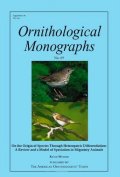
|
|
Thomas R. Howell's Check-List of the Birds of Nicaragua as of 1993 Editors: Juan C Martinez-Sanchez and Tom Will
Ornithological Monographs 68
American Ornithologists' Union
2010
A previously unpublished checklist of the birds of Nicaragua.
|
Buy from amazon.co.uk 
|
|
Avian SubspeciesEditors: Kevin Winkler and Susan M. Haig
Ornithological Monographs 67
American Ornithologists' Union
2010
A 200 page edition that collects 13 papers on avian subspecies that were delivered at the meeting of the A.O.U., the Cooper Ornithological Society and the Society of Canadian Ornithologists in Portland, Oregon during August 2008.
|
Buy from amazon.co.uk 
|
|
Cladistics and the Origin of Birds: A Review and Two New AnalysesFrances C James and John A Pourtless
Ornithological Monographs 66
American Ornithologists' Union
2009
A 78 page paper.
|
Buy from amazon.co.uk 
|
|
Reproduction and Immune Homeostasis in a Long-lived Seabird, the Nazca Booby (Sula Granti)Victor Apanius, Mark Westbrock, David Anderson
Ornithological Monographs 65
American Ornithologists' Union
2008
|
Buy from amazon.co.uk 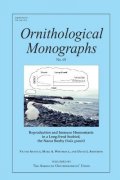
|
|
Conservation of Grassland Birds in North America: Understanding Ecological Processes in Different RegionsRobert Askins, Felipe Chavez-Ramirez, Brenda Dale, Carola Haas, James Herkert
Ornithological Monographs 64
American Ornithologists' Union
2007
A 46 page paper.
|
Buy from amazon.co.uk 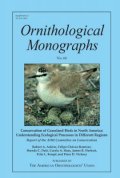
|
|
Festschrift for Ned K. Johnson: Geographic Variation and Evolution in BirdsEditor: Carla Cicero and JV Remsen
Ornithological Monographs 63
American Ornithologists' Union
2007
Contents:
- A Tribute to the Career of Ned K. Johnson: Enduring Standards through Changing Times
- Molecular Advances in the Study of Geographic Variation and Speciation in Birds
- Vainly Beating the Air: Species-Concept Debates Need Not Impede Progress in Science or Conservation
- Named Subspecies and Their Significance in Contemporary Ornithology
Distributional Dynamics of Invasion and Hybridization by Strix spp. in Western North America
- Divergence between Subspecies Groups of Swainson's Thrush (Catharus ustulatus ustulatus and C. U. swainsoni)
- Narrow Contact of Desert Sage Sparrows (Amphispiza belli nevadensis and A. B. canescens) in Owens Valley, Eastern California: Evidence from Mitochondrial DNA, Morphology, and GIS-Based Niche Models
- Statistical Assessment of Congruence among Phylogeographic Histories of Three Avian Species in the California Floristic Province
- The "Walking Eagle" Wetmoregyps Daggetti Miller: A Scaled-up Version of the Savanna Hawk (Buteogallus meridionalis)
|
Buy from amazon.co.uk 
|
|
Storm-petrels of the Eastern Pacific Ocean: Species Assembly and Diversity along Marine Habitat GradientsLarry B Spear and David G Ainley
Ornithological Monographs 62
American Ornithologists' Union
2007
A 76 page paper.
|
Buy from amazon.co.uk 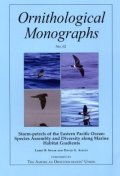
|
|
Patterns of Migratory Connectivity in Two Neararctic-Neotropical Songbirds: New Insights from Intrinsic MarkersMarylčne Boulet and D. Ryan Norris
Ornithological Monographs 61
American Ornithologists' Union
2006
Contents:
- Introduction: The Past and Present of Migratory Connectivity
- Migratory Connectivity of a Widely Distributed Songbird, the American Redstart (Setophaga ruticilla)
- Integrated Analysis of Genetic, Stable Isotope, and Banding Data Reveal Migratory Connectivity and Flyways in the Northern Yellow Warbler (Dendroica petechia; Aestiva group)
- Perspectives on Migratory Connectivity
|
 |
|
Current Topics in Avian Disease Research: Understanding Endemic and Invasive DiseasesEditor: John Faaborg
Ornithological Monographs 60
American Ornithologists' Union
2006
Contents:
- Avian Influenza in Wild Birds: Status as Reservoirs, and Risks to Humans and Agriculture
- House Finch (Carpodacus mexicanus) Population- and Group-Level Responses to a Bacterial Disease
- West Nile Virus in North American Birds
- Effects of West Nile Virus Mortality on Social Structure of an American Crow (Corvus brachyrhynchos) Population in Upstate New York
- West Nile Virus in the Permanent-Resident Bird Community of a Fragmented Ohio Landscape
- Health Assessment of Seabirds on Isla Genovesa, Galápagos Islands
- Avian Hematozoa in South America: A Comparison of Temperate and Tropical Zones
|
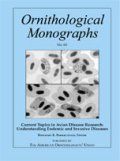 |
|
Modeling Approaches in Avian Conservation and the Role of Field BiologistsEditor: Steven R. Beissinger
Ornithological Monographs 59
American Ornithologists' Union
2006
"This review grew out of our realization that models play an increasingly important role in conservation but are rarely used in the research of most avian biologists. Modelers are creating models that are more complex and mechanistic and that can incorporate more of the knowledge acquired by field biologists. Such models require field ... more »biologists to provide more specific information, larger sample sizes, and sometimes new kinds of data, such as habitat-specific demography and dispersal information. Field biologists need to support model development by testing key model assumptions and validating models. The best conservation decisions wilJ occur where cooperative interaction enables field biologists, modelers, statisticians, and managers to contribute effectively. We begin by discussing the general form of ecological models-heuristic or mechanistic, "scientific" or statistical-and then highlight the structure, strengths, weaknesses, and applications of six types of models commonly used in avian conservation: (1) deterministic singlepopulation matrix models, (2) stochastic population viability analysis (PVA) models for single populations, (3) metapopulation models, (4) spatially explicit models, (5) genetic models, and (6) species distribution models. We end by considering the intelligent use of models in decision- making, which requires understanding their unique attributes, determining whether the assumptions that underlie the structure are valid, and testing the ability of the model to predict the future correctly."
|
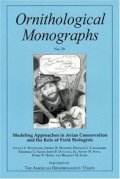 |
|
Ernst Mayr at 100: Ornithologist and NaturalistWalter J. Bock and M. Ross Lein
Ornithological Monographs 58
American Ornithologists' Union
2005
"Includes a complete bibliography of Mayr's works and a DVD with a biography and an interview with Mayr."
|
Buy from amazon.co.uk 
|
|
Management of Cowbirds and Their Hosts: Balancing Science, Ethics, and MandatesEditor: Catherine P. Ortega, Jameson F Chace and Brian D Peer
Ornithological Monographs 57
American Ornithologists' Union
2005
|
Buy from amazon.co.uk 
|
|
Prehistoric Human Impacts on California Birds: Evidence from the Emeryville Shellmound AvifaunaJack M. Broughton
Ornithological Monographs 56
American Ornithologists' Union
2004
|
Buy from amazon.co.uk 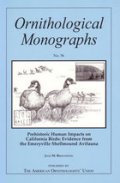
|
|
Obligate Army-ant-following Birds: A Study of Ecology, Spatial Movement Patterns, and Behavior in Amazonian PeruSusan K. Willson
Ornithological Monographs 55
American Ornithologists' Union
2004
|
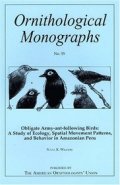 |
|
Population Dynamics of the California Spotted Owl (Strix occidentalis occidentalis): A Meta-AnalysisAlan B. Franklin, et al
Ornithological Monographs 54
American Ornithologists' Union
2004
"We conducted a meta-analysis to provide a current assessment of the population characteristics of California Spotted Owls (Strix occidentalis occidentalis) resident on four study areas in the Sierra Nevada and one study area in southern California. Our meta-analysis followed rigorous a priori analysis protocols, which we derived through extensive discussion during a week-long analysis workshop. Because there is great interest in the owl's population status, we used state-of-the-art analytical methods to obtain results as precise as possible. Our meta-analysis included data from five California study areas located on the Lassen National Forest (1990-2000), Eldorado National Forest (1986-2000), Sierra National Forest (1990-2000), Sequoia and Kings Canyon national parks (1990-2000), and San Bernardino National Forest (1987-1998). Four of the five study areas spanned the length of the Sierra Nevada, whereas the fifth study area encompassed the San Bernardino Mountains in southern California. Study areas ranged in size from 343 km2 (Sequoia and Kings Canyon) to 2,200 km2 (Lassen). All studies were designed to use capture-recapture methods and analysis. We used survival in a meta-analysis because field methods were very similar among studies. However, we did not use reproduction in a meta-analysis because it was not clear if variation among individual study-area protocols used to assess reproductive output of owls would confound results. Thus, we analyzed fecundity only by individual study area. We examined population trend using the reparameterized Jolly-Seber capture-recapture estimator."
|
Buy from amazon.co.uk 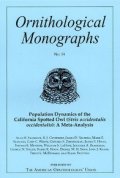
|
|
Evolution of Flightlessness in Rails (Gruiformes: Rallidae): Phylogenetic, Ecomorphological, and Ontogenetic PerspectivesBradley C. Livezey
Ornithological Monographs 53
American Ornithologists' Union
2003
|
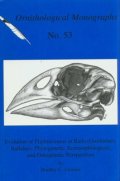 |
|
Ornithology of Sabah: History, Gazetteer, Annotated Checklist, and BibliographyFrederick H. Sheldon, Robert G. Moyle, Jody Kennard
Ornithological Monographs 52
American Ornithologists' Union
2001
"Sabah is the Malaysian State representing former British North Borneo. It is well known for its rich forests, impressive mountains (including Mt. Kinabalu), and diverse avifauna. Ornithologists have explored and published on the birds of Sabah since the 1850s. This monograph reviews the work of these ornithologists by providing an historical overview of their explorations and studies; a gazetteer describing the sites at which they worked; an annotated checklist summarizing what they learned about birds, particularly in regard to distribution, habitat preferences, and breeding; and a bibliography of ornithological and related publications. The purpose of this report is to set the stage for future research on the birds of Sabah. This goal is accomplished in two ways. First, by reviewing what has been done, the history and gazetteer serve as a guide for expedition planners, wildlife managers, conservationists, and other scientists as they seek information on study sites. Certain parts of Sabah have been well studied (e.g., the East and West coasts), but other areas are poorly explored (e.g., the north-central mountains and the south-central uplands). Second, by summarizing what is known about the birds of Sabah, the annotated checklist and bibliography provide a guide to research needs. Although a great deal is known about the distribution of birds in Sabah, remarkably little work has been done on bird ecology and evolution. Only a handful of modern, quantitative studies have been conducted on the population genetics, phylogeny, biogeography, migration, community ecology, or autecology of Sabah's birds. This dearth of ornithological information is a burden for conservationists, as they struggle to preserve the last bits of forest in Sabah, but it presents a great opportunity for bird researchers."
|
Buy from amazon.co.uk 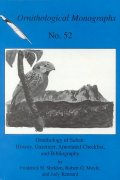
|
|
A Descriptive and Phylogenetic Analysis of Plumulaceous Feather Characters in CharadriiformesCarla J. Dove
Ornithological Monographs 51
American Ornithologists' Union
2000
"The variation in microscopic characters of plumulaceous feathers is well known to be useful as an aid in species identifications. However, until now, the phylogenetic significance of these characters has not been thoroughly investigated. In the first part of this study, electron and light microscopy were used to examine the range of variation in downy feather characters of more than 145 species of shorebirds (Charadriiformes) and outgroup taxa. The major results of Part 1 demonstrate that similarities and differences exist in the microscopic features within this order, that different downy types (true down vs. contour feather down) of the same individual may have different microscopic structures, that some shorebirds have villi (previously unknown on the barbule bases of this group), and 38 microscopic feather characters are deemed useful for phylogenetic study. In Part 2, parsimony analysis was used to assess the phylogenetic value of these characters by comparing feather results to hypotheses based on osteological data and traditional classification."
|
Buy from amazon.co.uk 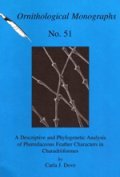
|
|
Avian Community, Climate, and Sea-Level Changes in the Plio-Pleistocene of the Florida PeninsulaSteven D. Emslie
Ornithological Monographs 50
American Ornithologists' Union
1998
"Eleven previously unidentified fossil avifaunas from Pliocene and Pleistocene localities in the Florida peninsula are presented, within which are included the description of a new species of anhinga (Anhinga beckeri), woodcock (Scolopax hutchensi), and pygmy-owl (Glaucidium explorator), and a new genus and species of condor (Aizenogyps toomeyae). The paleospecies Milvago readei, Dorypaltus prosphatus, and Protocitta dixi are considered to be synonymous with the living taxa Milvago chimachima, Vanellus chilensis, and Pica pica, respectively. These 11 avifaunas supplement the existing record of fossil birds from Florida that collectively provide a unique chronology of originations and extinctions of 239 extinct and extant taxa during a climatically dynamic period that began approximately 2.5 million years ago (Ma). Topographic and bathymetric maps of the peninsula are used with Geographic Information Systems software to model and correlate sea-level changes with the location and age of major fossil sites, the avian chronology, and presumed primary habitat of each represented taxon. These analyses indicate range expansions of Neotropical, western North American, and continental forest birds into the Florida peninsula during glacial stages, and the isolation, extirpation, or extinction of many of these taxa during interglacial stages."
|
Buy from amazon.co.uk 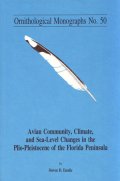
|
|